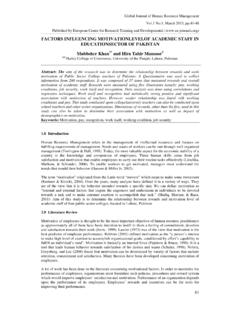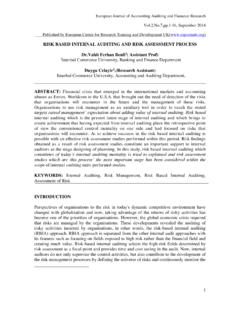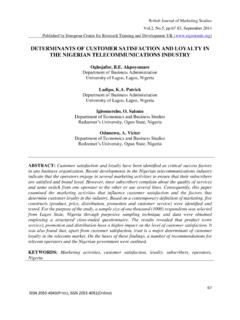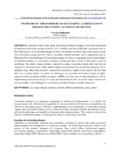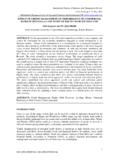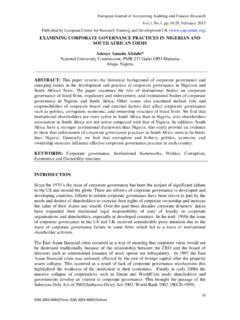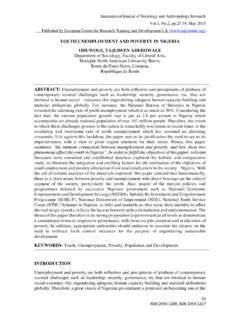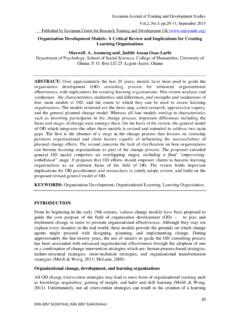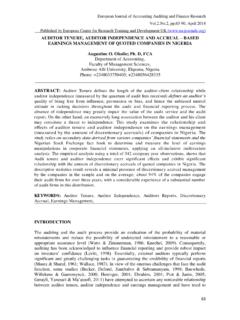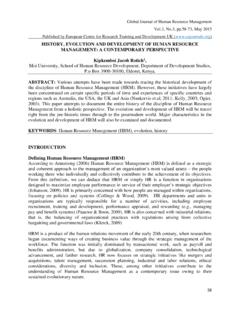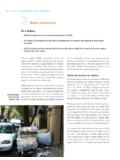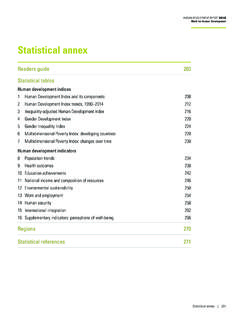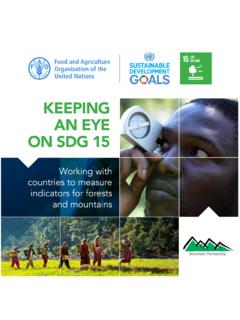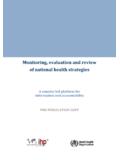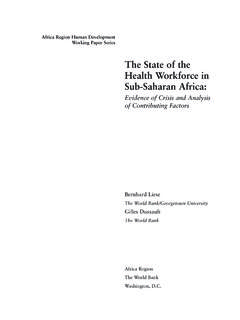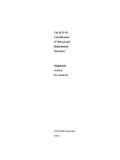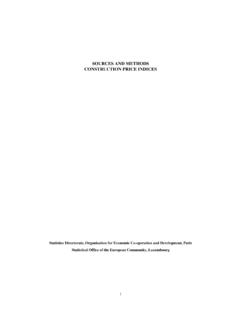Transcription of CHOOSING AN OPTIMAL EXCHANGE RATE REGIME: A …
1 International Journal of Developing and Emerging Economics , No. 1, , December 2013 Published by European Centre for Research Training and Development UK ( ) 11 CHOOSING AN OPTIMAL EXCHANGE RATE REGIME: A CRITICAL LITERATURE REVIEW Mustapha ZIKY*1 Aleksander BERENTSEN** Mariam OUCHEN ** ABSTRACT : This paper critically reviews the theoretical and empirical literature on the choice of EXCHANGE rate much has been learned in each approach, this paper highlights the areas of research in which our understanding of EXCHANGE rate regime is still incomplete.
2 Prominent issues include: (i) the discrepancy between declared and actual regime, and the different approaches of the EXCHANGE regime choice (ii) the critical review of the theoretical and empirical literature, (iii) the conclusion. KEYWORDS: EXCHANGE rate regime, The structural approach, Credibility, Flexibility, The bipolar view. JEL classification : F02, F31, F33, F36 INTRODUCTION The choice of an appropriate EXCHANGE rate regime for developing countries has been at the center of the debate in international finance for a long time.
3 What are the determinants of the choice of an EXCHANGE rate regime ? How would country circumstances affect the choice? What are the costs and benefits of various EXCHANGE rate regimes? The paper reviews recent trends in thinking on EXCHANGE rate begins by the classification of EXCHANGE rate regimes, noting the distinction between de facto and de jure. Then, it provides a review of the main issues in selecting an appropriate regime, and critically reviews these theories CLASSIFICATIONS AND THEORETICAL BACKGROUND OF EXCHANGE RATE REGIMES This section examines the distinct classifications (de jure and de facto) of EXCHANGE rate theoretical literature is surveyed.
4 Classification of EXCHANGE rate regimes IMF EXCHANGE Rate Classification Beyond the level of disaggregation of regimes is the system by which they are 1975 through 1998 the IMF classified members EXCHANGE rate arrangements under three main categories: pegged (against a single currency or a currency composite), limited flexibility vis- -vis a single currency or group of currencies, and more flexible, including other managed and independently floating. This grouping was based on members *Professor of Economics at Cadi Ayyad University Marrakesh, Morocco, Laboratory of innovation, responsibility and sustainable development **Professor of Economics at the University of Basel, Switzerland, Center of Economic Theory ** in Economics at Cadi Ayyad University Marrakesh, Morocco, Laboratory of innovation.
5 Responsibility and sustainable development International Journal of Developing and Emerging Economics , No. 1, , December 2013 Published by European Centre for Research Training and Development UK ( ) 12 official notifications or declaration to the IMF about their EXCHANGE rate policies and flexibility once becoming a member and after making any changes in their arrangements. A main shortcoming is that what countries are officially claiming to be doing (de jure) may differ largely from what they are actually pursuing (de facto).
6 This would reduce the transparency of the undertaken EXCHANGE rate policy and make effective tracking, surveillance and analysis of the EXCHANGE rate regime evolution and performance for research and policy implications difficult and perhaps less accurate or , EXCHANGE rate regimes often differed from those that had been declared. Consequently, the de jure classification inaccurately characterized the de facto regime. Recognizing this problem, the IMF itself moved to a new de facto classification that combined information on the EXCHANGE rate and monetary policy framework and policy intentions with data on actual EXCHANGE rate and reserves movements.
7 The existing IMF staff classification system has been modified to address these and other issues (see Appendix I table 1 for the new definitions). The revised classification has been published in the 2009 Annual Report on EXCHANGE Arrangements and EXCHANGE Restrictions (AREAER) and in the IMF s 2009 Annual Report. Specifically, the 2009 AREAER includes the revised classification at end-April 2009 and end-April 2008, and changes in the intervening period. Alternatives classifications While the new scheme adopted by the IMF in 1999 is a marked improvement over the former classification, the lack of historical database limits its usefulness for empirical analysis.
8 It is possible to identify instances in which actual regimes differ from the stated and Sturzenegger(2000) find that of the 35 countries identified as free floats in 1998, 12(all of them emerging countries) could not be considered and Reinhart(2000) even conclude that most countries identify themeselves as floaters actually follow more rigid EXCHANGE , Bubula and Otker-Robe(2002) construct a monthly database on de facto regime for all member countries that extends the current classification back in time from the begining of 1990 to the sample period is limited but its analysis is interesting because it differs from the facto existing classification LYS for instance which ignore the IMF s old official classification (Darne and Rippol 2004).
9 Appendix II Table 2 provides a brief review of the classification scheme starting from the most rigid regime and becoming increasingly flexible within each system. THEORETICAL LITERATURE REVIEW : An extensive theoretical literature is available on the optimum choice of an EXCHANGE regime. The first approach is the structural approach based firstly on the theory of the OPTIMAL currency area which focuses on a country s economic structural characteristics, so as to determine whether it would be better off in terms of its ability to maintain external and internal balance through a fixed as compared to a flexible EXCHANGE arrangement,and secondly.
10 On the nature of the shocks generated by changes in trade flows and by a deterioration in terms of trade. The basic conclusion of these studies is that the OPTIMAL choice of an EXCHANGE regime depends on the nature and size of these shocks as well as the structure of the economy (Fisher (1977), Frenkel and Aizenman (1982)). These analyses show that if the disturbances are foreign and domestic real shocks such as shift in the demand of domestic goods, and even foreign nominal shocks, a greater degree of flexibility is preferable.
